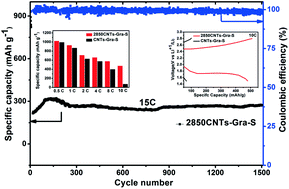Three-dimensional sp2 carbon networks prepared by ultrahigh temperature treatment for ultrafast lithium–sulfur batteries†
Abstract
The current challenge in the development of high-performance lithium–sulfur (Li–S) batteries is to facilitate the redox kinetics of sulfur species as well as to suppress the shuttle effect of polysulfides, especially at high current rates. Herein, aiming the application of Li–S at high current rates, we coupled a sp2 carbon configuration consisting of 3D carbon nanotubes/graphene prepared by ultrahigh temperature treatment (2850 °C) with S (2850CNTs–Gra–S) for application in Li–S batteries. The 2850CNTs–Gra as the host material exhibits a nearly perfect sp2 hybridized structure because ultrahigh temperature treatment not only repairs the raw defects in CNTs and graphene, but it also forms new sp2 C–C bonds between them. The 3D sp2 carbon network ensures ultrafast ion/electron transfer and efficient heat dissipation to protect the integrity of the separator when the Li–S battery is running at an ultrahigh rate. Based on these unique advantages, the 2850CNTs–Gra–S cathode shows a high current rate performance. Critically, it still delivers a considerable specific capacity after 1500 cycles even at a current rate of 15C and exhibits an extremely low capacity degradation rate of 0.0087% per cycle.



 Please wait while we load your content...
Please wait while we load your content...